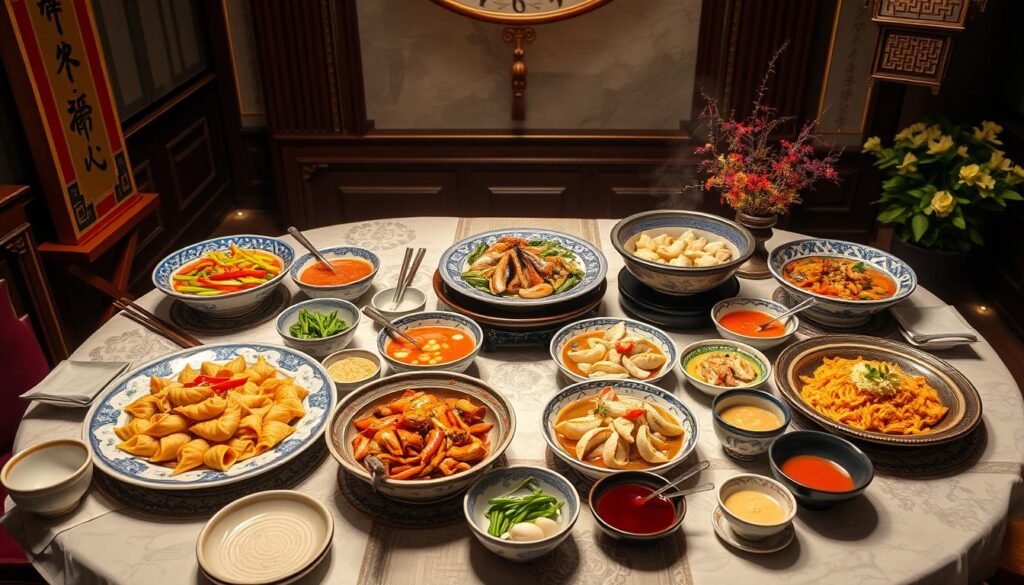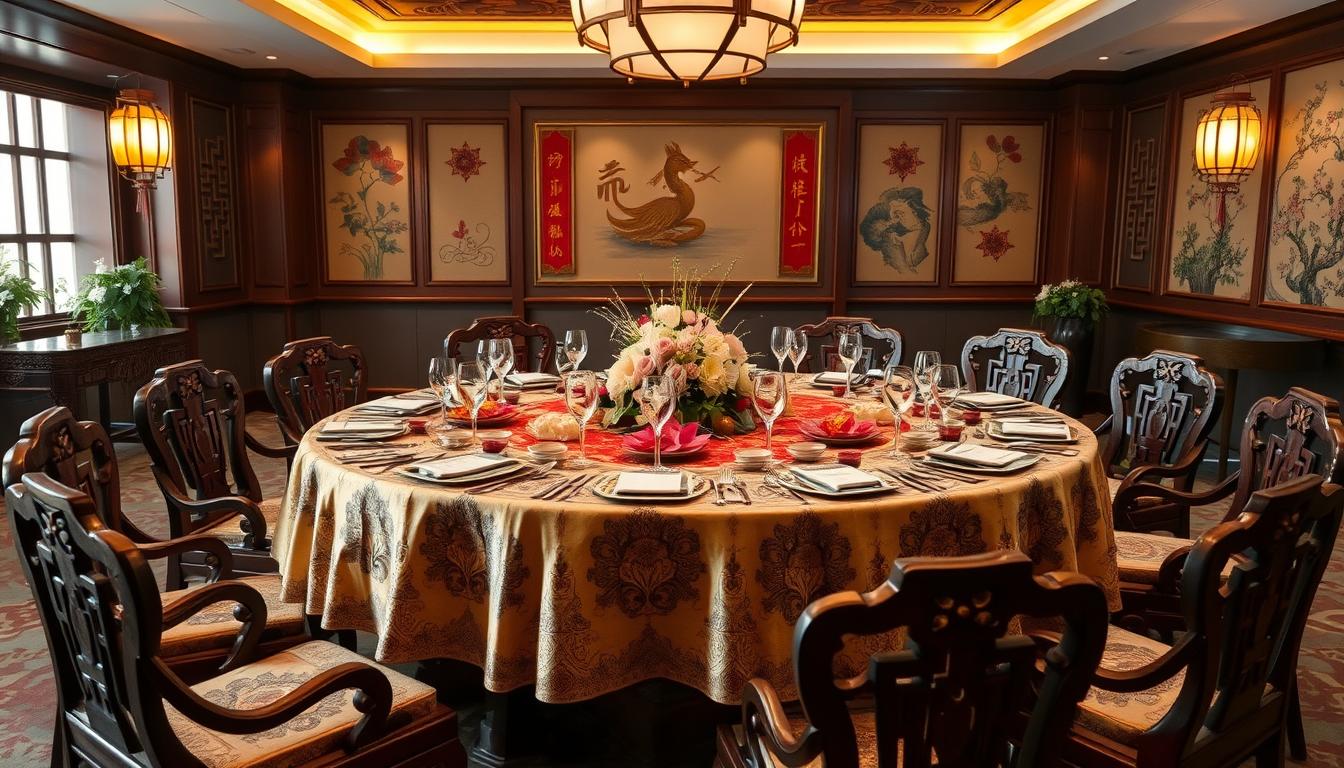Chinese food is more than just eating. It’s like a story told through dishes. A traditional Chinese 9-course dinner menu is special. It’s filled with symbols and deep meanings. The Chinese feast aims to bring joy and connection.
When making a traditional Chinese banquet, chefs pick ingredients with care. Each dish has its own special meaning. This makes the meal a celebration of life’s big moments.
To make a true Chinese meal, you need to know about flavors, textures, and symbols. Chinese banquets are for big events like weddings and the lunar new year. They show the wisdom and heritage of Chinese cooking.
Key Takeaways
- A 9-course Chinese dinner represents cultural complexity and tradition
- Each dish carries symbolic meaning beyond taste
- Ingredient selection is crucial in Chinese culinary arts
- Banquets reflect important life celebrations
- Presentation and symbolism are as important as flavor
Understanding Traditional Chinese Banquet Culture
Chinese banquet culture is very special. It’s all about food, friends, and family. It shows respect, luck, and peace.
Symbolic Meanings in Chinese Dishes
In Chinese food, each dish means something special. Ingredients wish for good things:
- Lobster symbolizes joy and harmonious unions
- Roast duck represents tranquility in relationships
- Abalone signifies abundance and good fortune
- Sweet buns with lotus paste bring sweetness and happiness
Importance of Even Numbers in Course Selection
Even numbers are key in Chinese dining. They mean balance and fullness. A wedding banquet has 10 or 12 dishes for luck and perfection.
| Number of Dishes | Symbolic Meaning |
|---|---|
| 8 Dishes | Prosperity and Good Luck |
| 10 Dishes | Completeness and Perfection |
| 12 Dishes | Happiness Throughout the Year |
Traditional Table Settings and Etiquette
Chinese dining is all about respect and family. Everyone sits together. This shows unity and care in how dishes are served.
“In Chinese banquet culture, every dish tells a story, every bite carries a blessing.”
Essential Chinese 9-Course Dinner Menu Components
Making a traditional Chinese banquet menu is like telling a story with food. It’s about flavors, textures, and respect for tradition. Each dish is a part of a journey that honors the past.

A traditional Chinese banquet menu is carefully planned. It starts with 3 to 5 appetizers. These dishes prepare you for the feast to come.
“In Chinese dining, each course is a chapter of a delicious narrative.” – Traditional Culinary Wisdom
- Appetizer Platter: Often featuring spring rolls and delicate cold cuts
- Soup Course: Typically includes Hot and Sour or Shark’s Fin soup
- Seafood Selections: Prawns, scallops, and exotic preparations
- Poultry Dish: Whole chicken or duck preparation
- Meat Course: Braised or roasted options
- Vegetable Interlude: Carefully selected vegetarian dishes
- Carbohydrate Course: Fried rice or E-Fu noodles
- Dessert: Red bean soup with traditional accompaniments
Traditional Chinese dishes are chosen with care. They make the meal balanced and meaningful. Main dishes, like the star of the show, make up 40% of the meal.
Pro Tip: In a traditional Chinese banquet menu, each course is chosen not just for taste, but for its symbolic meaning and cultural significance.
Now, 10-15% of the courses are vegetarian. This shows how Chinese dining traditions are evolving to meet modern tastes.
Conclusion
Planning a Chinese dinner menu is more than picking dishes. It’s a journey through centuries of cooking wisdom. It’s about understanding symbols, balance, and flavors that make a meal special.
Creating a real Chinese banquet needs lots of detail. Each dish has deep meaning, from the ingredients to the way they’re arranged. These show prosperity, unity, and good luck.
A Chinese 9-course dinner tells a story with food. It lets diners try new flavors and learn about food symbols. It’s a way to celebrate Chinese culture, whether for a family event or a big celebration.
This tradition is about more than food. It connects families, celebrates heritage, and shows the beauty of Chinese cuisine. By following these traditions, anyone can make a meal that honors this rich culinary history.
FAQ
What makes a traditional Chinese 9-course dinner special?
A traditional Chinese 9-course dinner is more than just food. It’s a special experience filled with meaning. Each dish is chosen for its special meaning, like wishing for good luck and happiness.
This meal is for big events like weddings and New Year’s. It’s a time to share joy and celebrate.
Why are there specifically 9 courses in a traditional Chinese dinner?
The number 9 is very lucky in Chinese culture. It means everything is complete, like the Emperor’s power. Even numbers are key, and 9 is the best for special meals.
Each dish is picked for its taste, texture, and meaning. This makes the meal balanced and full of meaning.
What are the typical courses in a traditional Chinese 9-course dinner?
A traditional Chinese 9-course dinner has many parts. It starts with appetizers, then soup, and seafood. Next come poultry, meat, and vegetables.
It ends with rice, noodles, and dessert. Each part is a journey of flavors and meanings.
How important is presentation in a Chinese banquet?
Presentation is very important in a Chinese banquet. Food must look good and have meaning. The way food is arranged and served is key.
It’s not just about taste. It’s about showing respect and celebrating the occasion.
What are some key etiquette rules for a Chinese banquet?
At a Chinese banquet, using chopsticks correctly is important. Don’t point or stick them in rice. Respect the seating order and try every dish.
Showing thanks for the meal is also important. It’s a way to honor the host and the food.
How can I source authentic ingredients for a Chinese 9-course dinner?
To find real ingredients, go to Asian grocery stores or farmers markets. You can also shop online. Look for fresh seafood, mushrooms, and special rice and seasonings.
Are there vegetarian options in a traditional Chinese 9-course dinner?
Yes, there are many vegetarian options in Chinese food. You can make stir-fries, use tofu, and try mushroom dishes. These fit well into the 9-course menu, keeping the tradition alive.

